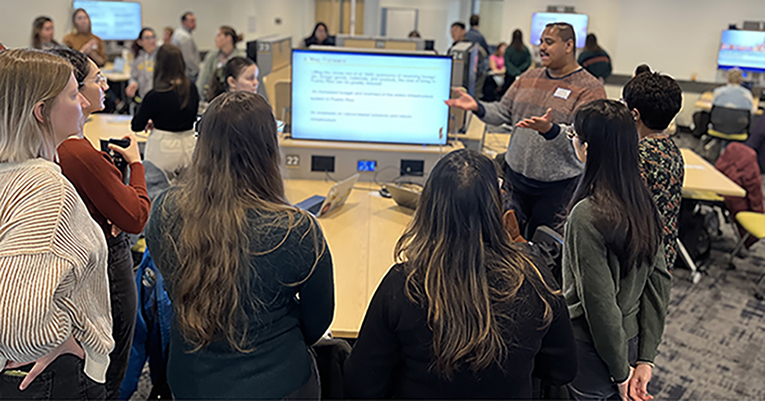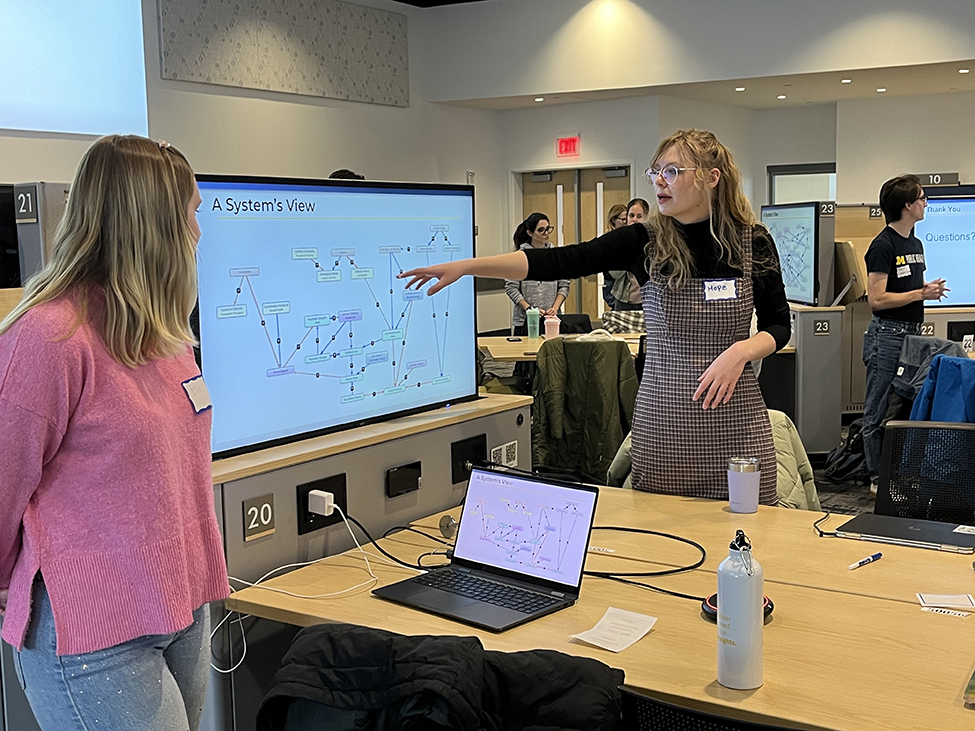Michigan Public Health students investigate health disparities in MPH Core Curriculum course

First-year Master of Public Health students from the University of Michigan School of Public Health’s new course “Investigating Public Health Issues” presented their end-of-the-semester projects Dec. 6. The Public Health 500 course is part of the MPH Core Curriculum that debuted in the fall semester.
Nearly 40 presentations were given on six topics—infant mortality, diabetes, cancer, climate change, gun violence and mental health—at the Central Campus Classroom Building, a 100,000-square-foot, state-of-the-art facility designed to support large innovative and interactive classes.
Over the course of the fall semester, MPH students from across the School of Public Health's academic departments worked in interdisciplinary teams, drawing expertise from a range of faculty to foster a holistic understanding of public health challenges and encourage innovative problem-solving. Core courses were taught by a team of six faculty across the school’s highly ranked departments.
“One of the foundations of this new core curriculum is the belief that every student has their own piece of the puzzle to add to public health and its major goal of making the world a better place for everyone,” said Sharon Kardia, senior associate dean for education and the Millicent W. Higgins Collegiate Professor of Epidemiology. “This project-based curriculum allows students to build public health products that could be of use to other public health professionals or within the community through city councils, local departments of health or healthcare systems.
“This semester, the teams created a comprehensive report on how to inform policy, public health stakeholders and the general public at the local level because public health is local. Next semester, those same teams will take a course called ‘Developing Solutions to Public Health Issues.’”
Each team had to select a public health issue in a US state to examine health disparities for one of the course topics. The teams then investigated and defined a pressing public health issue by using evidence-based approaches to public health, including calculating and interpreting epidemiological measures and performing statistical analyses.
“I think this class will benefit me for the rest of my School of Public Health career because it's taught me to work better with other people and to think about things through a bunch of different perspectives,” said Lydia Cutshall, a Nutritional Sciences student. “I could take this forward in my career and realize that sometimes when people are dealing with health issues, it’s not necessarily just one thing that’s causing the problem. It’s important to think about things holistically and then be able to start to work through all potential problems to find a solution.”
Students learned to identify appropriate resources to support their investigation of how key factors such as nutritional, environmental, healthcare access and policies and social determinants of health impacted their team’s public health issue and evaluating gun violence among adolescents in Detroit.
I think this class will benefit me for the rest of my School of Public Health career because it's taught me to work better with other people and to think about things through a bunch of different perspectives.”
— Lydia Cutshall, a Nutritional Sciences student
Cutshall and Nahim Miah were two team members who worked on the project “Disparities in Lung Cancer Incidence and Mortality in Appalachian Kentucky.” Both said they enjoyed working in a group setting that fostered collaboration.
“I love being able to work with students from pretty much every concentration and get multiple viewpoints on this single issue that we’re working on together,” Cutshall said. “I think it really helped to shed the light on our report on why Kentucky has a higher concentration of radon than any other state in the US.”
“I think it played out really well,” said Miah, an Epidemiology student. “All of our lab partners worked well together, and we all had unique things to say in terms of our different cultural backgrounds and different educational backgrounds. It was very helpful to get multiple perspectives and open our eyes to other forms of public health that we wouldn't have thought of beforehand.”
Kennedy Smith, a Health Management and Policy student, was on a team that looked at “Anxiety and Depression in Michigan (18-25-year-olds).” She said it was the first time she has worked on a project group that had five students.
“I felt like it allowed me to dive more specifically into anxiety and depression,” Smith said. “As someone who enjoys public health, I've done a lot of research about the topic, but doing specific research about a specific age group that I'm personally in and how that is affecting me was new. I really enjoyed that aspect of the class, and I think this class did a good job of bringing real public health issues together.”
Throughout the class, students learned to analyze the relative contribution of these factors through key public health frameworks, such as the social ecological model, and through a systems-based approach to public health. Their instruction was led by Michigan Public Health faculty Lynda Lisabeth, Matt Zawistoski, Michael Rubyan, Bill Lopez, Deborah Watkins and Elizabeth Hudson as well as Linda Gordon, associate director of the Center for Health Equity Practice at the Michigan Public Health Institute. It was supported by a series of formative assessments, including quizzes, reflections, response papers and problem sets. The semester’s work culminated in each team completing a public health report, an authentic summative assessment that showcased their knowledge gained during the semester, which resulted in their presentations.

